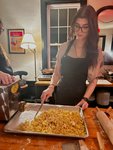
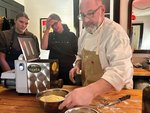
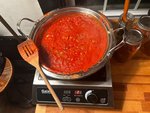
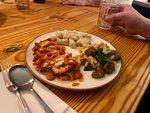
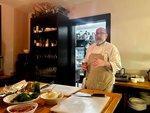
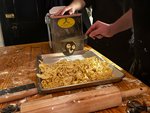
DELHI – In addition to being delicious and affordable, pasta is an extremely versatile grain that can be made with different bases and techniques, and topped with a variety of sauces to appeal to any taste. There is a pasta dish for everyone, no matter one’s preference. Gerald “Gerry” Pellegrino, owner of Strickland Hollow Tasting Room & Bottle Shop offers cooking classes, including pasta making classes, where he teaches people how to make pasta, and for those in the know, how to make pasta better.
In his “Art of Making Pasta” series, Pellegrino teaches techniques to make three types of pastas using different types of flours, in a way that showcases his knowledge of food genetics and flavors.
His passion for food preparation, appreciation of real, fresh ingredients and how flavors and texture compliment each other is palpable in the kitchen where the smell of sauteing garlic, onions, and olive oil, caramelized for nearly two hours, tantalizes the senses.
The ingredients are the base for a rustic mushroom ragù, his burgeoning culinary students make to top the pasta.
Pellegrino, a veteran cuisinier, has owned and operated multiple restaurants including Corks, an award-winning restaurant in Baltimore, Md. He also co-founded Schola in 2015, a kitchen in Baltimore that offers a full schedule of cooking classes, where his vision of creating a space people could learn to cook in a comfortable, fun environment - came to life. Pellegrino’s instruction is less like taking a class, and more like learning to cook from a family member.
Pellegrino introduced the types of pasta on the evening’s menu: gnocchi, which is potato-based; cavatelli, made with ricotta cheese and all-purpose flour, and rigatoni, made with semolina flour.
Peeling potatoes to make the gnocchi transported students back to their childhood; hovered by a mother worried about a finger nicked by a peeler.
While some peeled, others grated, with Pellegrino monitoring progress and sharing his expertise and preference of baked rather than boiled potatoes, a final step before adding flour and kneading the gnocci dough.
Gnocchi is a rounded pasta, with ridges on one side, and a dimple on the other to hold sauce, Pellegrino said. “There’s no gnocchi police, but if it doesn’t have ridges and a dimple, it’s not gnocchi.”
To make the pasta, the dense dough is rolled into a long, rope-like cylinder - not unlike making a Play doh snake at the age of four - then cut into small pieces with a bench knife. Gnocchi can be rolled with a fork, but Pellegrino’s kitchen, is equipped with gnocchi paddles which make forming the dough less intimidating.
It seems simple: place dough on a paddle and roll it down the ridges with the pad of your thumb to create the rolled shape. Inconsistency in shape is good, Pellegrino declares of students’ efforts. “That’s how you know it’s homemade,” he comforts.
Cavatelli dough, made with ricotta cheese, is lighter and wetter than gnocchi dough. Pellegrino models how to roll the cavatelli dough, cut it into thin strips, and run it through the cavatelli roller. After struggling to roll consistent gnocchi shapes, using a cavatelli machine is a breath of fresh air as each caterpillar-shaped piece is uniform. The main attraction, which mesmerized all participants, was the pasta extruder. Pellegrino added semolina flour and water in the extruder to create the rigatoni dough - which looked much more like damp, clumpy sand than pasta dough. The extruder, Pellegrino explained, churns the mixture and pushes it through the mold. The die heats and slightly cooks the outside of the pasta to ensure it holds its shape.
While pasta boiled, Pellegrino supervised students chopping sausages, onions, and mushrooms, and picking fresh herbs for the sauces to pair with each pasta. A Sicilian chef and caterer with a deep passion for her career, who was a class participant, assisted Pellegrino in preparing the rue for a roasted garlic sauce to pour over the gnocchi. While the sauce thickened, sausage, garlic and spinach were married in a pan to create a sauce for the cavatelli; while an fragrant mushroom ragù was prepared for the rigatoni.
The results revealed a faint earthy tasting gnocchi, buried among other flavors. A dash of red pepper flakes to the ghnocchi added the perfect touch of zest and fire.
The rigatoni, topped with mushroom ragù, is a vegetarian’s dream. Thick cut mushrooms and plump, vibrant tomatoes perfectly mimic meat-based sauce. This dish embodies comfort food - like sitting around the family dinner table on a Sunday evening, sharing unwavering and contrasting opinions, with an appreciation of food.
Rigatoni is thin and light, a contrast to the thick sauce which reinforced the idea that opposites attract.
The sweet sausage, pungent garlic, earthy spinach, and fresh pasta took center stage on the cream-colored plates.
While students dined, snippets of nonas’ and grandmothers’ cooking secrets were passed around the table, along with laughs, and a visible appreciation for carbohydrates.
Pellegrino’s love of food andis weaved into every aspect of the class - from his casual yet thoughtful approach to instruction, to his rant on why “tofurky,” a plant-based substitute for a turkey, should not exist.
A class at Strickland Hollow will leave one with respect for the versatility and ease of pasta.
To further share the love, Strickland Hollow will host Valentine’s Day themed classes Thursday, Feb. 9 and Saturday, Feb. 11, including a candy making class “Candies for your Sweetheart,” and an “Aphrodisiac’s Dinner.” Classes can be booked on Strickland Hollow’s website stricklandhollowfarm.com/team-3.